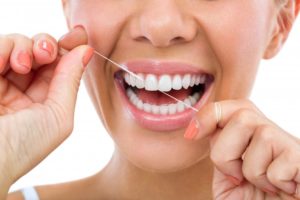 Do you brush your teeth twice a day? Do you visit the dentist every six months for an examination and thorough cleaning? If so, great job! It sounds like you’re on your way to achieving optimal oral health. However, along with these habits, you’ll need to start flossing at least once a day. If this surprises you, you’ll want to keep reading.
Do you brush your teeth twice a day? Do you visit the dentist every six months for an examination and thorough cleaning? If so, great job! It sounds like you’re on your way to achieving optimal oral health. However, along with these habits, you’ll need to start flossing at least once a day. If this surprises you, you’ll want to keep reading.
According to your dentist, flossing isn’t exclusively for removing pieces of food from in between teeth after a meal. While this is important, it’s not the only task flossing accomplishes.
Why is Flossing Important?
When you brush your teeth, the bristles of your toothbrush can only reach so far. Even interdental toothbrushes cannot reach the deep pockets of your gums and the sides of your teeth. In fact, it’s estimated that only about 65 percent of your teeth are cleaned when you brush alone. That means the remaining 35 percent needs to be cleaned with floss.
While it’s important to remove small pieces of food from your teeth and gums, you should really be focused on removing plaque buildup. When plaque collects over time, it eventually turns into a hardened, calcified form know as tartar. This material can only be removed by a dentist, but you can reduce it by making sure you floss daily.
What If I Don’t Floss?
Plaque begins to form shortly after you’ve removed it, so it’s important to stay on top of your oral care routine. Without removing plaque, your teeth will start to take on a more yellow tint. It can also lead to cavities forming on the side of teeth as plaque is able to release more and more acids.
A larger problem that can surface by not flossing is gum disease. When left untreated, plaque and tartar begin to irritate the gums, causing them to become seriously inflamed, red, and even painful or sensitive to touch. If you’ve ever noticed your gums bleed while brushing, it means you’ve reached the earliest stage of gum disease known as gingivitis. After enough time, it can turn into periodontitis, which cannot be reversed like gingivitis. To avoid sensitivity, receding gums, and eventually tooth loss, take the steps to floss properly every day.
How Do I Floss Properly?
Start by pulling out 12 to 18 inches of floss at a time and wrap it around each index finger. Leave a small gap in between your fingers; this will be the space you use to floss your teeth. Once wrapped, carefully slide the floss in between each tooth, working your way all the way around the bottom and top arches.
Make sure you don’t snap the floss when you go to remove it as this can damage your tooth enamel. If you struggle to floss properly, switch to a floss that is thinner and designed for tighter teeth. Consider buying a handheld floss holder to make reaching the back teeth easier.
Need more tips on flossing effectively? Your dentist can help! Schedule an appointment with them today!
About the Author
Dr. Nicholas Brong is always happy to help patients improve their at-home oral care routines, especially if they are young and still learning good technique. To learn more about his practice or preventive treatments, contact him through his website.





